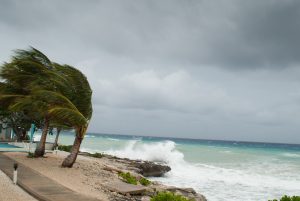Posted on October 18, 2022 by Jeff Civins
Hurricane Ian brought “fierce winds, unrelenting rains and catastrophic flooding to southwest Florida. As Ian approached, Florida, Governor Ron DeSantis acknowledged that, “We all need to work together regardless of party lines,” expressing thankfulness for the Biden administration’s assistance. Offering Governor DeSantis the “fullest federal support,” President Biden echoed the Governor’s thought, stating: “At times like this, America comes together. We’re going to pull together as one team, as one America.”
The willingness of the two potential rivals for the 2024 White House to cooperate in meeting the immediate threat of Ian is admirable. However, that cooperation masks the failure of federal and state governments, and the private sector, to work together to tackle climate change, which likely exacerbated the intensity and destructiveness of that storm. New data from NASA, the New York Times reports, revealed that warm ocean waters fueled Hurricane Ian to become one of the most powerful storms to strike the U.S. in the past decade, bringing “fierce winds, unrelenting rains and catastrophic flooding to southwest Florida.” The Times goes on to point out that scientists say that climate change has made hurricanes more powerful, as warmer waters strengthen and sustain them. And even a slight rise in sea level makes the threat of a storm surge that more terrifying.
There is, however, a model for governmental cooperation even though it has not yet proved workable for addressing the challenge of climate change in the absence of an immediate crisis.
The model, upon which most federal pollution statutes are based, is that of cooperative federalism, the idea that the federal government sets minimum national standards for specific environmental media with states then being able to obtain authority for developing and implementing programs to meet those standards. In its strategic plan, “Working Together,” EPA even explains that environmental protection is a shared responsibility among the states, tribes, and the federal government. Regrettably, in the absence of a threat that is immediate and palpable, like a hurricane, the concept in practice has often been an oxymoron, with states litigating to undermine or reject national programs to reduce carbon emissions.
Illustratively, in 2016, 24 states sued to block the Obama administration’s Clean Power Plan, which was intended to cut carbon dioxide emissions from fossil fuel fired power plants to help halt climate change, while 14 states plus DC and other cities, sought to uphold it. Although that rule never went into effect, the U.S. Supreme Court, in West Virginia v. EPA, upheld the petitioners’ challenge and determined that Congress did not grant EPA authority to devise emission caps based on generation shifting—away from coal. Whatever the merits of the Clean Power Plan, it never went into effect. But its proposed goal–to reduce the use of coal in the power grid is being achieved by economic factors. The litigation demonstrates that protecting citizens exposed to storms like Ian continues to give way to partisan division until the imminence of a disaster is recognized.
And think about the role that partisan division continues to play in trying to protect our Earth. As a result of the “shale revolution,” the US has become a net total energy exporter since 2019, making natural gas more plentiful and cheaper and the US more energy independent. Meanwhile, the Biden Administration has committed the US to net zero carbon emissions by 2050. These facts raise a key question: recognizing that a diversified mix of energy sources is necessary to assure adequate energy, which energy mix should we pursue to achieve net zero carbon? Perhaps governments and private interests can work together cooperatively and objectively to answer it and other pertinent questions. For example, should each potential energy source be evaluated based on all its environmental impacts over its life cycle, or only on its impact on climate change? And should energy poverty be factored into the decision-making and, if so, how? And perhaps most significantly, can policymakers make good choices without the immediacy of a natural disaster forcing them to cooperate?
There are hopeful signs in the marketplace. Responsible business organizations are focused on achieving net zero carbon, and promoting socially responsible investment taking into account environmental, social, and governance (ESG) factors. ESG investing raises questions of its own: what ESG parameters are to be considered and how are they to be measured? And, in particular, may a carbon-conscious fund invest in a fossil fuel company that is developing carbon capture technology and has committed to zero carbon? And, again, importantly, will policymakers in parallel support ESG initiatives through a vision motivated by what will happen in the future to our Earth in the absence of governmental cooperation and public-private partnerships.
Immediacy cannot be a prerequisite to cooperation on climate change. Yet that the focus on a looming crisis leads to cooperation among federal, state, and private interests demonstrates that where there is a will, there is a way. Or, more aptly, as Bob Dylan wrote, “the answer is blowin’ in the wind.” Let’s hope that the lesson of Hurricane Ian will elevate all politicians above the partisan fray on climate change.

